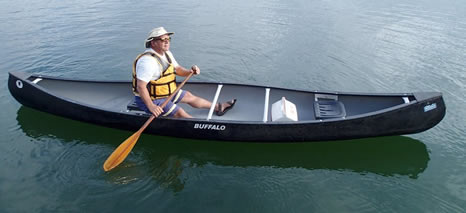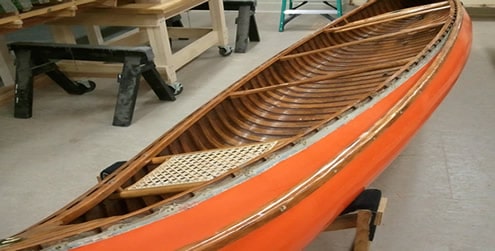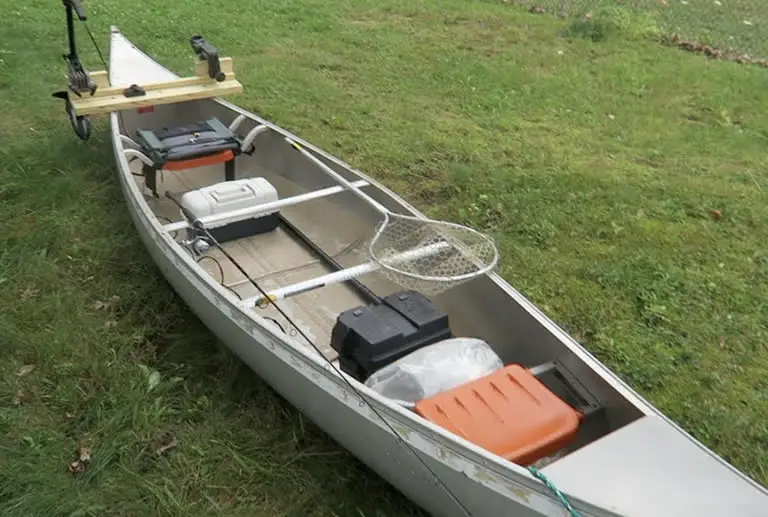Canoe outfitting is the process of equipping your canoe with certain modifications so that it is better suited to specific activities such as fishing, hunting, or recreational use. A canoe can also be outfitted with items designed to improve boat safety and enhance comfort.
Contents
Why do we need to outfit canoes?
Outfitting a canoe is a process of adding modifications to the boat and this is done for various reasons.
One of the most common reasons for adding modifications to a canoe is for added protection. Adding protective features to a canoe is one way to outfit the boat for improved safety. Other common outfitting modifications include adding items to the canoe that result in additional comfort to the overall canoeing experience.
The two most common types of outfitting modifications made to a canoe are for:
- Added safety.
- Increased comfort.
We will cover these safety and comfort modifications throughout the article. However, these two common outfitting modifications are far from the only ones available and many of the modifications that fall into those two categories are actually added to make a specific canoeing activity either safer or more comfortable, or both. So the safety and comfort modifications made to a canoe can vary from one activity to another.
The main types of outfitting modifications made to a canoe to make it more suitable for specific types of activities include:
- Fishing.
- Hunting.
- Racing.
- Whitewater, touring and recreational use.
Outfitting a canoe for fishing
The most common type of canoe outfitting carried out by avid anglers has to do with convenience rather than safety or comfort.
Here are some of the modifications that anglers regularly make to their canoes:
- Adding fish finders and transducers.
- Installing anchors and outriggers.
- Mounting an appropriate motor.
- Installing elevated and/or swivel seating.
Fish finders and transducers
Fish finders are a big help for anglers that want to get bigger hauls when they go out to fish.
Fish finders usually consist of a transducer that uses a sonar to track the location of fish below the boat. The transducer then sends that signal back to a display mounted on the boat.
There are fairly compact fish finders that are a good fit for a canoe and the ones that are suitable for a Jon boat, as we covered in this article, are ideal for canoe use also.
Transducers are usually mounted on the side of the canoe, though owners of fiberglass canoes will tend to integrate it permanently into the canoe’s hull by gluing it with epoxy. If you integrate the transducer with epoxy then make sure it has no air bubbles in it because they tend to interfere with the transducer and produce false signals.
Anchors and outriggers
When you are fighting to reel in fish, or pull in a haul, the force may often make a canoe rock back and forth, so to counter this unwanted action many canoe owners will install outriggers or use anchors to help them stabilize the canoe when they are fishing.
You can easily buy outriggers and anchors from your local store, or online, but there are easy ways to create and fit your own outriggers to a canoe as we outlined in this article. Outriggers are also a great way to make a canoe more stable if you intend to use it in the ocean.
An anchor is also a good way to stop your canoe from being carried on the current and if you are an avid angler then you will definitely want to install at least one anchor on your canoe. In many instances going for a double anchor approach is best though.
Motor mounting
Mounting a motor may not be the first modification you would think of making to a canoe but having a mechanical means of propulsion is a good addition to any boat because it gives you the convenience of not having to paddle your way to your fishing spot.
Adding a motor also helps stabilize the canoe when you are battling with a big fish because you can use it to counter the force.
Of course motors on most fishing vessels are only really useful for moving from one fishing spot to the next as the sound of the motor will often scare away the fish. But as mentioned above a motor can also be used to regain control and balance when battling with a particular large fish. It is also useful for helping to battle water currents and for travelling upstream.
There are a lot of suitable trolling motors for sale on the market though you must be aware of the limitations imposed on your choices due to the nature of a canoe’s hull design. If you want to mount a motor on a canoe you should read our article can you put a motor on a canoe which is packed with helpful and practical information about suitable motors and appropriate sized engines for your boat.
Adding elevated and/or swivel seats
Just like a Jon boat, a canoe has seats that sit low in the boat. This is far from ideal for fishing.
These seats also tend to be fairly uncomfortable with sustained long-duration use.
If a canoe is used for fishing and no additional elevated or swivel seating is added then anglers will often tend to stand on the boat which leads to certain stability issues. Although these stability issues can be offset by adding outriggers to the canoe a much easier, more comfortable and convenient option is to install elevated seats.
Just as a sit-on-top fishing a kayak has elevated seats, unlike a traditional sit-in kayak, you can also add elevated seats to a canoe to make it easier to cast-off and reel-in (you can learn more about sit-in and sit-on-top kayak differences here). The elevated seat also gives you a better vantage point for viewing fish.

Though a stationary elevated seat will be more than sufficient for most canoeist you should also consider installing a swivel seat so you can easily switch your attention from one side of the canoe to the other by merely swinging your seat around.
Outfitting a canoe for hunting
When hunting in a canoe it is best that the items that you use to outfit your canoe are of neutral colors, or camouflaged because you do not want ducks to see you right off the bat.
Below are some modifications that you can add to your canoe if you use it for hunting:
- Camouflage.
- Concealment items.
- Light sources.
- Storage units.
Camouflage
Adding camo to a canoe can really help with stealth when it comes to hunting.
Believe it or not camouflaging a canoe is a relatively easy process than you can do yourself. Our article showing how to camouflage a Jon boat will walk you through the process as the steps are exactly the same for camouflaging a canoe.
Concealment items
Sometimes an all out camo paint job on your boat is not an option. Fear not because there are alternatives.
Concealment items will help you camouflage your boat when you need it.
Some examples of ways to conceal your canoe are fake grass coverings and camouflage burlap. Both of these are used to cover your canoe and both are readily available locally or online.
Light sources
This is essential for people who want to hunt because sometimes you do it early in the morning or late in the evening when light is low. This makes lighting a good idea for bass fishing as well.
Deck mounted lights that are removable are a great addition for any hunting canoe as they not only help to illuminate your prey but a good light source will also help you see where you are going in reduced light.
You can use LED lights that can be decked mounted, or a handheld search light, like this deck light with suction cup, that can also be deck mounted and easily removed. Alternatively, you can simply wear a headlight that is battery-powered though strictly speaking this is not outfitting your canoe.
There are a range of lights available that are well fitted to canoe use and the choice you make will mostly likely be based on personal preference.
Storage units
Whether you want a place to store gear, keep a catch fresh or simply to cool your beer and food, permanent storage units are a great modification to add any canoe.
Permanent storage units can be placed under seating areas (especially if you have added elevated seats) or at the bow or stern of the canoe thus utilizing space that is often unused. Even if you do usually store gear or equipment in these locations having a permanent, easily-accessible, storage unit makes storage and retrieval of items much easier.
A permanent storage unit is also a good way to better utilize the available space by allowing you to stack or compact items better. Adding storage units is an especially big benefit for anyone who loves to go camping as you will need to utilize your space effectively as we outlined in our ultimate boat camping guide.
Outfitting for racing or just for added safety
Most of the modifications that are made to to a racing canoe are designed to optimize the boat for safety. However, safety is something that you should always prioritize on any boat, not just in racing but in canoeing in general.
So adding any or all of these outfitting modifications will go a long way to increasing your safety while on the water no matter what canoeing activity you are involved in.
Here are some of the safety outfitting modifications that many canoe owners will make to their boats:
- Splash/spray rails.
- Spray deck.
- Foot braces.
Splash/Spray Rails
Splash rails, unlike with other boats, are usually placed along the outwales of your canoe using contact cement. Many other boat types will place splash rails at the lower bottom part of the hull but on a canoe they work best higher up on the boat nearer to the waterline.
Splash rails are often made from a foam material. They are a great and simple way to help decrease the amount of water splashing up and into the canoe when it passes by rapids or turbulent water. Instead of the water splashing into the canoe, the rails direct the water outwards and away from the boat.
Although, most people who use their canoes recreationally rarely consider outfitting their boat with this modification the advantage that the rails give is a great feature to consider. Racing boats are commonly fitted with splash rails.

Spray deck
Another way to keep water from splashing into your boat is to use a spray deck. The spray deck is similar to a kayak spray skirt and works in a similar way.
Essentially the spray deck covers the open deck of the canoe, with an opening “cockpit” for the paddler, and conforms to the shape of the boat. These elasticated covers are easily fastened and held in place with Velcro making them easy to remove as well.
Foot braces
Foot braces are installed in the bow of the canoe or towards the middle rear for the paddler sat in the stern.
This is a recommended modification for your canoes because it helps with adding some resistance when using your foot while you are paddling. This helps in the efficiency of each stroke and aides with stability as well.
You can purchase foot braces at a reasonable price online or at local stores or you can choose to construct a makeshift foot brace using ropes and some wood.
Outfitting for whitewater, touring and recreational use
People outfitting their canoe for whitewater rapids, touring or recreational use usually do it because they want their canoes to be safer and more comfortable for them to use.
Here are some of the modifications commonly outfitted on canoes used for those purposes:
- Flotation bags.
- Grab loops.
- Kneeling thwart.
- Lacing.
- Painter line.
- Painters.
- Comfortable yokes.
Flotation bags
Flotation bags help the canoe stay afloat even when water goes inside the hull or when the boat begins to sink.
Adding flotation bags is helpful for river touring if the the rivers contain rapids. But, of course, adding flotation bags is a safety measure you should consider even if you do not use your canoe in whitewater environments at all.
If you do plan to use your canoe in whitewater rivers then I recommend you read our article what is river rafting as it contains information on the different types of rapids you may encounter. Although that article is written for rafters the information on rapids is equally applicable to canoeists and kayakers who ride rapids.
Grab loops
Grab loops are a great aide when it comes to carrying your canoe because they give you something something to hold on to.
Aside from this, the grab loops can also be tie-off points for mooring or, in the event of rescue or boat retrieval, as tow lines.
Adding grab lines to a canoe is an easy modification to make that you can do by yourself.
Lacing the canoe
Lacing your canoe can be helpful for securing items to your boat. For example, you can easily secure your flotation bags or waterproof packs filled with items that you are bringing with you on your canoeing trip to the lacing on the canoe. By adding some items, in secured airtight waterproof bags, to the lacing on the outside of your canoe and allowing them to float alongside the boat you can free up both space and weight on your canoe.
Lacing the canoe is usually done all around the boat and this can be achieved easily and quickly as shown in the video below.
Kneeling thwart
A kneeling thwart adds comfort for your knees while canoeing because, as every canoer knows, it can get fairly uncomfortable being in a kneeling position for an extended period of time.
You can simply add some padding to the area of your your canoe where you usually kneel or simply buy kneeling pads for extra protection for your knees.
Adding a painter line
A painter line is just a strip of rope that is around three-fourths of the canoe’s length. This is made shorter to avoid the rope being tangled up.
Usually, a painter line is tied to the grab loops of the canoe and at the end of the painter line you can loop it in to an overhand knot.
The main purpose of a painter line is for lining the canoe, but it could also be useful when towing the canoe. It can also be used to ‘walk’ your canoe through shorelines.
Comfortable yokes
A yoke of the canoe is the cross beam located at the center of the canoe. This usually has a curved indentation at the center so that it would be comfortable for the canoeist to carry the boat.
The yoke rests on the shoulders of the person carrying the canoe, so it is important to have a really comfortable yoke especially when there are long walks that you have to endure when carrying the canoe over land.
Some people, add padding to soften the area that comes in contact with their shoulders while others just opt to buy a better yoke and replace the one that came with the canoe when they first bought it.

